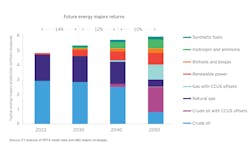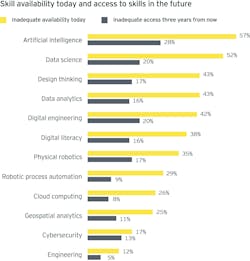New technology propels major productivity gains offshore, EY reports
Editor's note: This article first appeared in the 2024 Offshore Business Strategies Special Report, which published within the May/June 2024 issue of Offshore magazine.
By Josh Loftus and Brian Harry, Ernst & Young LLP
Today’s dynamic energy marketplace has put a renewed focus on offshore oil and gas operations as higher oil prices, coupled with the inherent efficiency of offshore, are making these projects attractive.
According to Rystad Energy research, offshore oil and gas investments accounted for 30% to 35% of total upstream investments in 2023. Moreover, as technology advances, deepwater projects are becoming more common. Deepwater accounts for 16% of global oil production today, up from 6% in 2013, with additional production expected. Nearly 40 deepwater or ultradeepwater projects are currently under development, with 60% of those projects expected to become operational in the next three years, according to a 2022 Wood Mackenzie report.
Though offshore oil and gas operations require significant capital investment, the ability to integrate advanced technology and new processes are transforming these assets, enabling operators to drive greater efficiencies, improve human capital needs and drive strong commercial results.
Emissions management
Technology has become an intrinsic part of emissions management, contributing significantly to operational efficiencies in offshore operations, particularly deepwater projects. Offshore operators are integrating emissions data with operational data, fostering end-to-end efficiencies.
While the technology on these offshore assets is still maturing, it is advanced enough to enable companies to produce large volumes of low emissions barrels in deepwater. As an example, closed cycle combustion technology in offshore operations can continuously recirculate emissions through gas turbines, generating power, while simultaneously reducing atmospheric pollution and driving operational costs down.
In other areas, by collecting emissions data and using machine learning, operators can better predict asset performance, run times, and strategically schedule and manage turnarounds as needed, all leading to enhanced asset life-cycle management and reduction in life-cycle and operating costs.
Remote operations
Today, the expanded use of automated operations for offshore production also plays a key role by reducing the need to house large numbers of workers on offshore assets. This is taking place in more mature offshore basins, such as the Gulf of Mexico and North Sea, as well as in emerging basins such as offshore Guyana.
Deploying unmanned offshore assets represents a significant shift in the industry in terms of how they position their workers. As a result, many companies are reviewing their human capital strategy to find new roles for highly skilled workers who are no longer needed to staff drilling rigs. The evolution to remote operations is increasing the need for operators to upskill their workers in advanced and digital technologies to harness the full potential of the investments.
At the same time, the shift to unmanned assets may also help the oil and gas industry in becoming a more appealing career choice for millennial and Gen Z employees, which is critical as the industry faces increased retirement and tighter labor pools. These generational cohorts have expressed a desire for gamified work environments and greater work-life balance.
Leveraging data
Offshore has always been a leading driver of technological advancement, which is taking center stage in the energy transition. Incorporating the data culled from emissions management efforts into other parts of the operation enables stronger collaboration within organizations and with potential new external partners, setting the stage for a new frontier of offshore oil and gas development.
With oil prices remaining relatively high, offshore production will likely continue to be a viable option for oil and gas companies through 2024 and into 2025. As offshore operations continue to expand in untapped regions, the industry will need to further embrace these emerging trends to tap innovative business models, develop new commercial opportunities and continue their focus on lowering emissions.
Editor's note: The views reflected in this article are the views of the authors and do not necessarily reflect the views of Ernst & Young LLP or other members of the global EY organization.
About the Author

Josh Loftus
Josh Loftus is a director at Ernst & Young LLP, focused on energy transition and decarbonization strategies for energy companies.

Brian Harry
Brian Harry is a managing director at Ernst & Young LLP in the Business Consulting practice, focused on digital transformation in the oil and gas sector.


